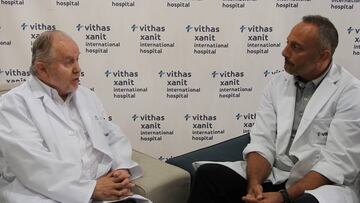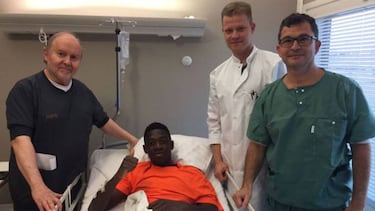Dr Sakari Orava: "We need more research on major tendon injuries"
The leading sports medicine specialist Sakari Orava, the surgeon who repaired Dembélé's ruptured hamstring, discusses major tendon ruptures.

Francisco Moya, a sports medicine specialist interviewed Sakari Orava, the surgeon who operated on Barcelona player Dembélé after he suffered ruptured hamstring on his LaLiga debut against Getafe.

Full transcript of the interview:
FM: Hello, my name is Francisco Moya, I’m a consultant in emergency and exercise sports medicine, with special interest in football medicine. I work at Vithas Xanit International Hospital in Benalmádena, Málaga, Spain. And I am here with Professor Sakari Orava who is probably one of the world’s most renowned sport and orthopaedic trauma surgeons and he also works with us the Vithas Xanit International hospital as an external consultant, a visiting consultant, and he also works as a professor and an orthopaedic trauma surgeon in a hospital in Turku in Finland.
FM: Let me start by asking why do tendons break? Why do big tendons break?
SO: That’s a question that we are not yet ready to answer. There are a lot of things that are still open. We know that tendons are very strong structures and especially big tendons in the human body tolerate a lot of pull, weight and stress. However, in sudden, explosive, unexpected motions they can rupture, as often happens during sports and exercise.
FM: In your experience, with the big tendons that break, that suffer a complete rupture, do you think these are healthy tendons, or do you think there is some previous damage, that there is a change in the histopathology, leading to the devastating injury?
SO: Yes, healthy, strong, big tendons do not rupture during sport or exercise; there has to be something in the tendon itself, so-called degenerative changes, and this is like summing up several old, small injuries: scarring, micro-tears, circulation disturbances, and this degeneration means the tissue becomes softer, weaker and in a tendon it happens partially there, along the long fibres, therefore the tendon may become weaker, even if it’s not painful and people don’t suffer from any symptoms before the total breakdown happens.
FM: Obviously that can explain… sometimes we see in the media when a famous sportsman or sportswoman suffer these devastating injuries, but the actual action leading to that rupture is actually an action involved in normal play or normal actions, like kicking a ball, or back heeling or starting a run or changing direction. That might be in the context of our ongoing lack of knowledge, as in how we can explain, although we are learning, to learn more and more, as time goes by, about these injuries and maybe that’s why it’s striking that normal actions can lead to these devastating injuries.
SO: Yes, that’s right. Sometimes we see total tears, for example in Achilles tendons, that happen after really very minimal trauma, but there has to be in the background these degenerative changes, old injuries, and of course during the game, or play or long running, or exercise, like, a tendon becomes tired, and the structure is not functioning normally and then something unexpected happens, like a sudden turn, kicking, rotation or sudden exercise, even if it’s small, but it’s like it’s unexpected, and then a total tear may happen.
FM: Obviously, we can elaborate and we can think of potential factors that can contribute to these acute and devastating events, but some of these we cannot evidence with science, as we speak. Probably we are starting to get know to more about what factors these could be to contribute to these. Sometimes people say the [playing] surfaces, the stress of the competition, or the exercise or your pelvic core stability, etc, etc, etc. Obviously this is something that personally, you and I, have been discussing, that there seems to be an increase in these kinds of injuries nowadays. But you and I know that the world of sport has taken steps to people being superhuman, like training regimes, competitive regimes, and just the example that in the 60s in football, people in competitive matches only running four or five kilometres, and now they are running 13 kilometres. So these could be factors that contribute to tendon injuries, and you are one of the best to tell us. Do you think now there are tendon injuries and overuse injuries and these kind of factors, especially because of the way in which sport is played and competative sport is performed. That could heavily contribute… though there will be other factors that we don’t know, but only identifying that for having those kind of injuries nowadays.
SO: Yes, that’s true, all those factors you said, they are in the background, the demands of top level sports today are higher than before, the playing season is longer, competitive periods are longer than before, and what has been forgotten, not totally, but partially, is that athletes need rest periods, muscles and tendons need a rest period, low level training, and in this way build up the musculoskeletal system to be stronger again to tolerate the next season.
FM: Yes, and obviously people that are involved in profesional football now… the tide is turning, to try to prevent [injuries] with these rest periods, trying to prevent overtraining syndrome. And we know that in a period possibly of training, training, training, now we are going back to the importance of rest and I know that professional clubs, the training sessions are not so long lasting and they are trying to prevent and trying to protect the players, with rest, which is possibly the best healer.
SO: That’s right, and what, on the other hand, is a good thing is that all these professional clubs, even the smaller clubs, have physiotherapists and very good rehabilitation regimes which can help athletes to come back and even if the rest periods are short, the athletes do well by all possible conservative means available today, and I think that’s one reason why they can play such a long season. First, like LaLiga period here, all winter, then the Champions League, then other European leagues and other matches.
FM: And national teams…
SO: And national teams as well. It’s incredible they tolerate such a long time at such big, maximum stress.
FM: And just to finish, two questions. One is: how can we prevent these injuries, with evidence based medicine, using a scientific method, to prevent these injuries, specifically tendon injuries and in competitive sports.
SO: Yes, that’s right. I think there are no very good means to prevent totally these tendon muscle injuries but we can, for example apply special training, to increase the coordination, balance, strength, speed, and I think that is done by all good coaches, but we still need to concentrate more on that. And what is the other thing, we need to build up inside clubs or teams, the physiotherapists team, and the coaching team to see that players are different, some play their whole lives without a single injury in tendons or muscles, and some suffer often from them. So that those [players] who will have these problems at a young age can be put through a special training to prevent the injuries occurring later.
FM: It’s great to have you here and we’ve discussed all this through all these years we’ve known each other and it’s something we always analyse and this my personal opinion after working with so many European top clubs, is that the medical departments in the clubs are under-resourced to be able to that, to produce the individual passport of a player. What you need to invest, what you need to know to be able to look after a top player as if they were a Formula 1 car, I mean if you see a picture of a Formula 1 car, with all the people and there’s one person in charge of one bolt, to do what they need to at a precise time and probably we, from the outside, and we are lucky to be outside and not linked to any specific club, to be able to say we would like the players to be looked after in that way. To say every individual player has to have an individual passport, an injury history and possibly specific training methods for them. And we know some clubs are starting to do it, starting to follow that policy. Just to add to everything, I would like to say that FIFA, on the medical side with the 11+ program, they are trying to create a program that is evidence based and it reduces injuries by 30%, overall, not specifically musculoskeletal, and that’s a nice program and they are trying to spread it all over the world. And it’s a very easy program for any competitive team - they don’t have to be professionals, any coach can learn it, and I think anything that can prevent injuries overall is very good. Just the final question… I know that one of the most difficult questions we can have in medicine but especially in sports medicine is when to operate? When do we have to operate on these kind of injuries? Before the interview we had a debate about a study you’re conducting about conservative [treatment] v operating on injuries, because obviously from a patient perspective to face an operation is always a stress factor, so what are your views on that?
SO: It is actually very difficult to say with an injury when it should be operated on, you have to make an individual decision and I think that it help a lot when one has seen a lot of different injuries before and then we have a patient in front of us and we do our clinical examination and we see the MRI images and then we can estimate, sometimes with a 'fingertip' feeling, this injury needs to be operated, otherwise it will not become good, or it will have recurrence later… then something will need to be done, and maybe the later operation is more difficult. So it can be said that it’s an individual decision. And with experience it’s much easier to do it.
FM: Obviously the message is that sometimes in medicine it’s an art more than science, but it’s a combination of both. As we know, some decisions in medicine are easy, but most of the decisions we have to make are not that easy. And you have to have the experience and the knowledge, to link up with the patient in order to see what the best treatment is for them and do things individually. Well, Sakari, I don’t know if you want to add anything else to this topic…
Related stories
SO: Nothing special, just that we are not ready yet with muscle and tendon problems. We still need time, we still need to continue research on these problems and try to find out better conservative treatment methods and also develop our operative methods to help athletes and players in the future more than today.
FM: Well Sakari, it’s been, as always, our pleasure to have you around and to learn from you, even better as a friend than a professional, but in both. Thank you.